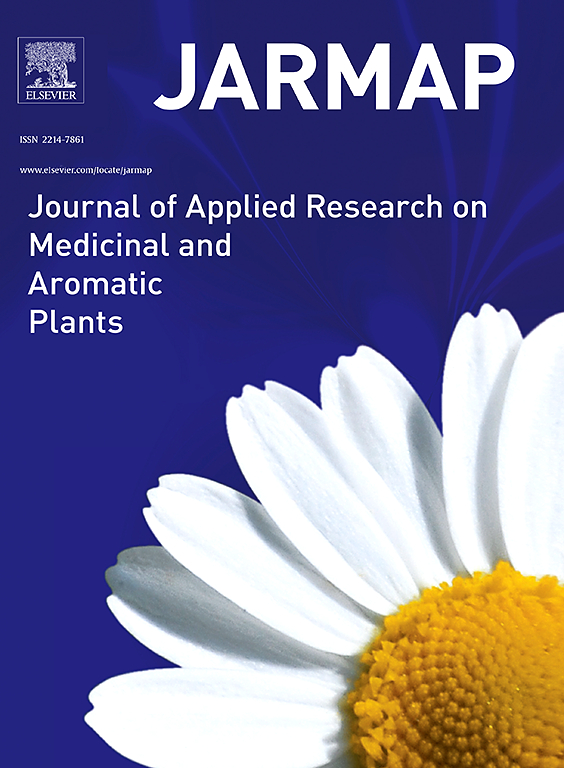贵州皂荚自然居群荚果和种子性状表型多样性分析
IF 3.6
2区 农林科学
Q1 PLANT SCIENCES
Journal of Applied Research on Medicinal and Aromatic Plants
Pub Date : 2025-09-30
DOI:10.1016/j.jarmap.2025.100666
引用次数: 0
摘要
为了揭示贵州皂荚自然居群的表型变异程度和变异格局,为皂荚的遗传改良、种质鉴定和品种选育奠定理论基础。本研究对贵州省17个天然白杨居群180株的种子和荚果的12个表型性状进行了测定,发现了丰富的表型多样性。结果表明,贵州赤杨种子和荚果表型变异极为丰富,居群内变异是主要变异源。平均表型分化系数为23.87 %,平均变异系数为11.59 %。青松种子和荚果表型性状的变异在地理上是不连续的。豆荚沿同一经度呈南北变异,种子沿同一经度呈东西变异。荚果居群间变异率(14.67 %)高于种子居群间变异率(8.96 %),说明荚果性状的变异较大,种子性状的稳定性较高。这种多层次的变异为创新利用中华香椿优质遗传资源提供了科学依据。主成分分析结果表明,前3个主成分(荚果大小、种子大小和重量、荚果重量)占累积贡献率的81.9 %,基本反映了白羊草表型性状的大部分信息。以12个荚果和种子性状为指标,综合评价黄杨自然居群的综合表现,发现CeHeng (CH)居群的综合表现最好,其次是WangMo (WM)、DeJiang (DJ)和瓮安(WA)居群。根据育种目标,从这四个群体中选择合适的育种材料。本研究结果为推进中华赤杨遗传改良奠定了重要基础,并为中华赤杨育种策略和管理实践的制定提供了科学依据。本文章由计算机程序翻译,如有差异,请以英文原文为准。
Analysis of phenotypic diversity in pods and seeds traits of natural populations of Gleditsia sinensis in Guizhou Province, China
In order to reveal the phenotypic variation degree and variation pattern of the natural population of Gleditsia sinensis in Guizhou Province, and lay a theoretical foundation for the genetic improvement, germplasm identification and variety breeding of G. sinensis. This study measured 12 phenotypic traits of seeds and pods in 180 individual trees from 17 natural G. sinensis populations in Guizhou Province and detected rich phenotypic diversity. The results suggest that the phenotypic variation of G. sinensis seeds and pods in Guizhou is extremely rich, with intrapopulation variation being the primary source of variation. The average phenotypic differentiation coefficient is 23.87 %, and the average coefficient of variation is 11.59 %. The variation in phenotypic traits of G. sinensis seeds and pods is geographically discontinuous. Generally, pods show north-south variation along the same longitude, while seeds exhibit east-west variation along the same latitude. Inter-population variability in pods (14.67 %) is higher than in seeds (8.96 %), suggesting greater variability in pod traits and higher stability in seed traits. This multi-level variation provides a scientific basis for the innovative utilization of high-quality genetic resources of G. sinensis. Principal component analysis shows that the first three principal components (size of pods, size and weight of seeds, weight of pods) account for 81.9 % of the cumulative contribution, essentially reflecting most of the information on phenotypic traits of G. sinensis. A comprehensive evaluation of the natural populations of G. sinensis based on 12 pods and seeds traits finds that the CeHeng (CH) population has the best overall performance, followed by WangMo (WM), DeJiang (DJ), and Weng'an (WA) populations. Suitable breeding materials can be selected from these four populations based on breeding objectives. This research findings lay a crucial foundation for advancing the genetic improvement of G. sinensis and provide a scientific underpinning for the development of breeding strategies and management practices.
求助全文
通过发布文献求助,成功后即可免费获取论文全文。
去求助
来源期刊

Journal of Applied Research on Medicinal and Aromatic Plants
Pharmacology, Toxicology and Pharmaceutics-Drug Discovery
CiteScore
6.40
自引率
7.70%
发文量
80
审稿时长
41 days
期刊介绍:
JARMAP is a peer reviewed and multidisciplinary communication platform, covering all aspects of the raw material supply chain of medicinal and aromatic plants. JARMAP aims to improve production of tailor made commodities by addressing the various requirements of manufacturers of herbal medicines, herbal teas, seasoning herbs, food and feed supplements and cosmetics. JARMAP covers research on genetic resources, breeding, wild-collection, domestication, propagation, cultivation, phytopathology and plant protection, mechanization, conservation, processing, quality assurance, analytics and economics. JARMAP publishes reviews, original research articles and short communications related to research.
 求助内容:
求助内容: 应助结果提醒方式:
应助结果提醒方式:


